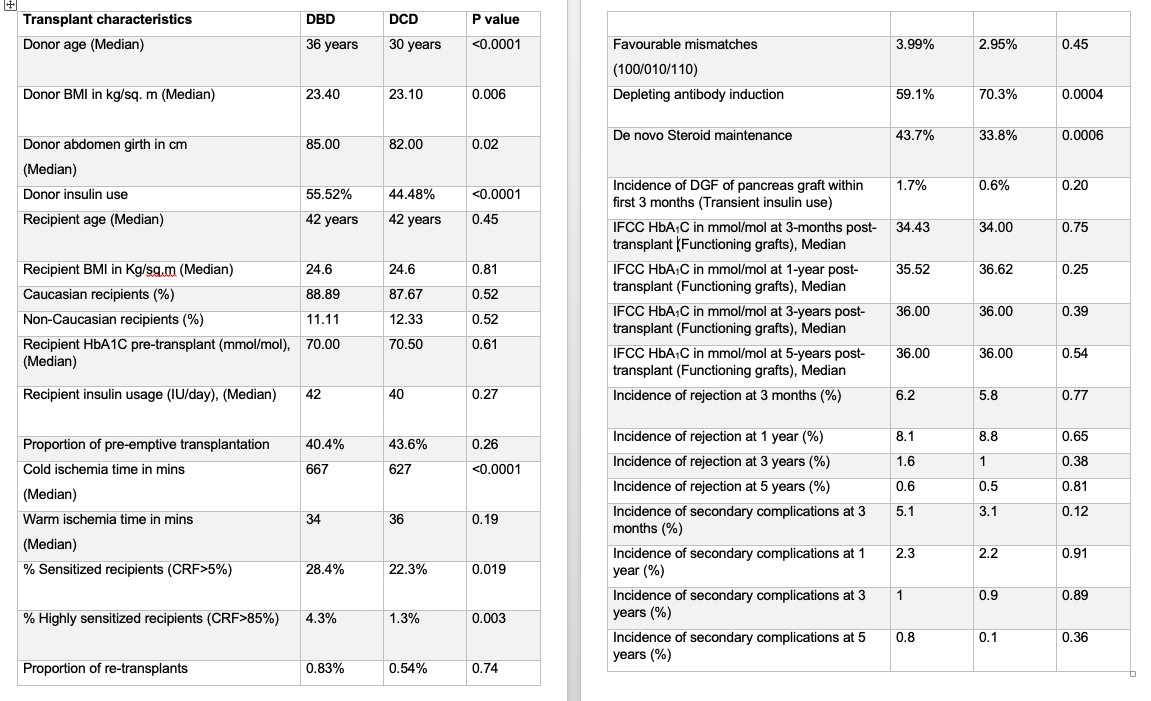Metabolic Outcomes After Simultaneous Pancreas Kidney Transplant from Donation After Circulatory Death Donors – The UK Registry Analysis
Imperial College Renal and Transplant Center, Hammersmith Hospital, Imperial College Healthcare NHS Trust, London, United Kingdom
Meeting: 2022 American Transplant Congress
Abstract number: 1160
Keywords: Donors, non-heart-beating, Kidney/pancreas transplantation, Outcome, Pancreas transplantation
Topic: Clinical Science » Pancreas » 65 - Pancreas and Islet: All Topics
Session Information
Session Name: Pancreas and Islet: All Topics
Session Type: Poster Abstract
Date: Sunday, June 5, 2022
Session Time: 7:00pm-8:00pm
 Presentation Time: 7:00pm-8:00pm
Presentation Time: 7:00pm-8:00pm
Location: Hynes Halls C & D
*Purpose: DCD pancreas transplantation is established as a valuable cohort to expand the pancreas donor pool, with equivalent graft & patient survival compared to pancreases from DBD donors, but the metabolic outcomes are unclear. Given the lack of metabolic markers, can post-transplant HbA1C predict long-term graft function, and does it predict function in both DBD & DCD grafts? We aimed to answer these questions.
*Methods: A UK registry analysis of 1985 SPK transplants (DBD=1612, DCD=373, excluding graft losses < 3-months) performed from 2005-2018 was done. The primary aim was to compare the metabolic outcomes (HbA1C & weight gain), rejection rate (includes the need for steroids) & incidence of secondary diabetic complications post-transplant between the 2 groups. The secondary aim was to correlate HbA1C to graft outcomes. Functioning graft is defined as remaining insulin independent. HbA1C <42mmol/mol was considered normal. Secondary diabetic complications are defined as any of the following: myocardial infarction, cerebrovascular accident, limb amputations.
*Results: Transplant characteristics and outcomes as shown in table 1. In univariate analysis, HbA1C was similar in both the cohorts; DBD recipients gained more weight at 1- & 3-years post-transplant (p=0.04 & 0.01, respectively). Patients who were de-novo steroid-free subsequently had a higher rate of steroid usage if they received a DCD graft (p=0.0003). In an adjusted multivariate logistic regression model for predicting weight gain, DCD recipients had a higher probability of weight gain at 1-year (OR 1.57, p=0.01). In both DBD & DCD grafts, a normal HbA1C at 3-months & 1-year predicts better longer-term pancreas graft survival [HR 2.01 & 2.12, respectively, (Fig 1)].
*Conclusions: DCD-SPK transplants have comparable HbA1C and secondary diabetic complications post-transplant but are associated with a higher risk of weight gain and likely to need more steroids. A normal HbA1C at 3-months & 1-year predicts better longer-term pancreas graft survival in both DBD/DCD grafts.
To cite this abstract in AMA style:
Gopal J, McLean A, Muthusamy A. Metabolic Outcomes After Simultaneous Pancreas Kidney Transplant from Donation After Circulatory Death Donors – The UK Registry Analysis [abstract]. Am J Transplant. 2022; 22 (suppl 3). https://atcmeetingabstracts.com/abstract/metabolic-outcomes-after-simultaneous-pancreas-kidney-transplant-from-donation-after-circulatory-death-donors-the-uk-registry-analysis/. Accessed January 6, 2026.« Back to 2022 American Transplant Congress


